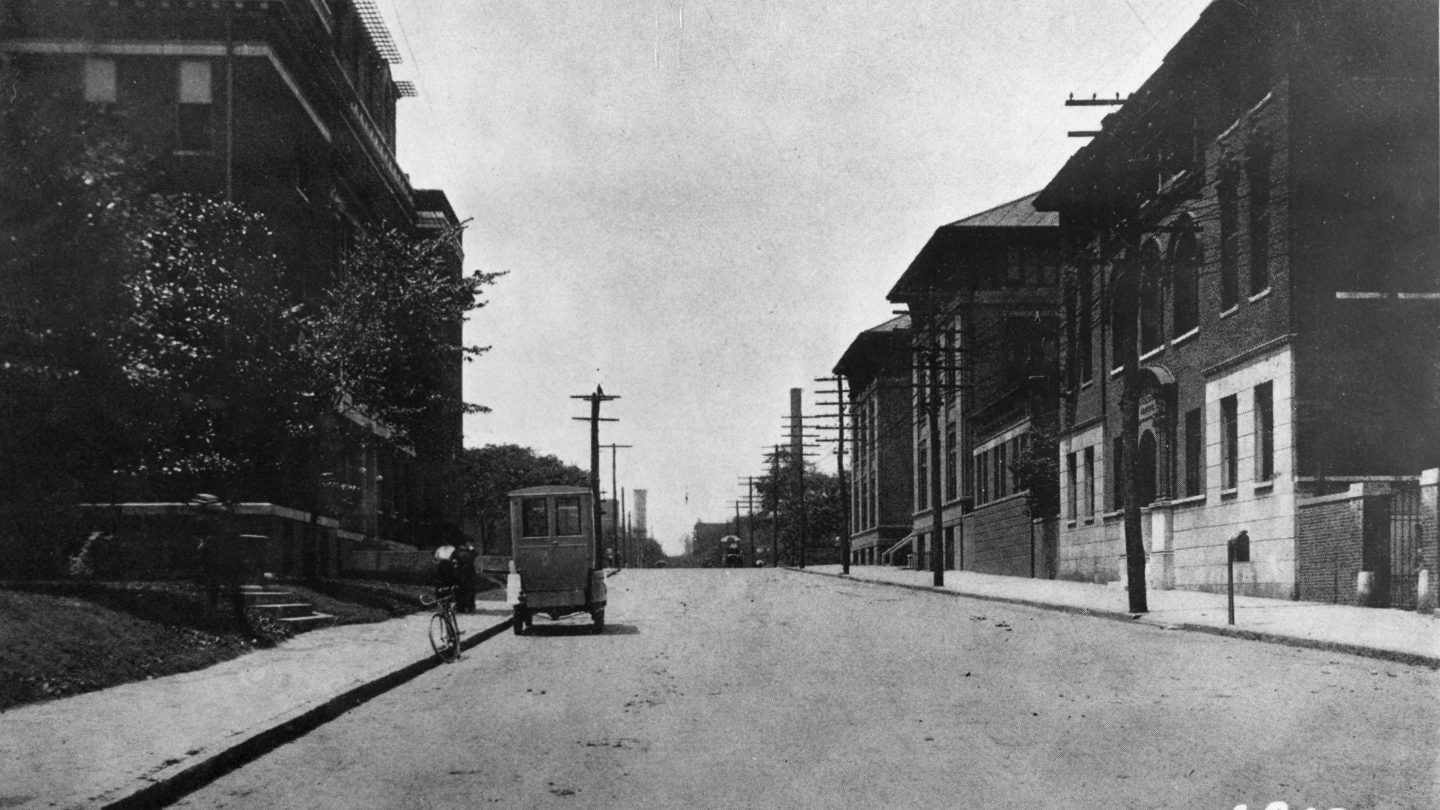
View of Butler Street (now Jesse Hill, Jr. Drive), lined with buildings belonging to Grady Memorial Hospital and Atlanta Medical College in 1912.
We’re living through a new era of public health. One in which working remotely and learning at a distance is rapidly becoming the norm—even when we aren’t under quarantine. As our city navigates new challenges related to the spread of COVID-19, we wanted to share some insight into the necessary work Grady Memorial Hospital has done, and continues to do, in our community.
Grady Health System has been a cornerstone of the Atlanta medical community since 1893. The core facility grew from one ward with 100 beds to include tens of departments, facilities, and clinics, including the Steiner Clinic, the Georgia Poison Center, the Georgia Comprehensive Sickle Cell Center, and the Ponce De Leon HIV/AIDS Center, amongst others.
Last year, Atlanta History Center processed two collections centered around Grady Memorial Hospital—the Grady Memorial Hospital collection (MSS 429) and the Nancy C. Wooten Grady Memorial Hospital records (MSS 570). What does it mean to “process” something? In archives or museums, when we process a collection it means that we arrange the contents and publish a descriptive inventory on our online finding aid database. It’s similar to taking inventory in a stockroom or creating a table of contents for a textbook. While these documents aren’t yet online, the initial act of processing increases the visibility of our archival materials and makes them much easier to search.
These collections document the history of Grady Memorial Hospital from 1894 through 2014. During those 120 years, Grady became the largest hospital in Georgia as well as one of the busiest Level 1 trauma centers in the country. Today, the hospital sees almost 700,000 patients a year—that’s roughly 12% of metro Atlanta’s population.
A view of Grady Memorial Hospital under construction in 1954. The new building had 21 floors, 1100 beds, and 17 operating rooms.
Grady served as a training ground for student doctors at Atlanta Medical College (which later became Emory University’s School of Medicine) and Morehouse School of Medicine. The hospital also operated in-house nursing schools from 1898 until 1982. The Grady Memorial Hospital collection contains all sorts of material from the hospital’s schools of nursing, including bulletins, newsletters, alumni information, and lecture notes. These documents can be used to learn about the history of healthcare, medicine, and nursing in Atlanta as well as the city’s growth through the 20th century.
The Grady Memorial Hospital collection also includes minutes from board of trustees and staff meetings, and correspondence from medical staff. These documents provide an invaluable inside look at monumental moments in the facility’s history—including desegregation. Like much of the South, between 1912 and 1964 Grady was racially segregated. There existed separate nursing schools for whites and African Americans, as well as a private hospital—the Hughes Spalding Pavilion—for African American patients to be treated by African American physicians.
Nurses at work in the new state-of-the-art facility in Downtown Atlanta in 1955.
The Nancy C. Wooten Grady Memorial Hospital records tell the facility’s history on a more human scale. Wooten was herself a registered nurse who worked at Grady for 32 years in various capacities, including as the registrar and field director of the School of Nursing. She documented the hospital’s expansion, programs, events, and personalities for decades. In many ways, her work compliments the minutes and notes contained in the Grady Memorial Hospital Collection. The scrapbooks, while centered around Wooten’s own experience, help to put faces with names and gives us a clearer picture of Grady’s legacy.
If you’re interested and would like to learn more about Grady, we are here for you. As stewards of public history—and public health—the Kenan Research Center at Atlanta History Center has temporarily closed; however, that doesn’t mean you can’t explore the past with us!
Though the Nancy C. Wooten Grady Memorial Hospital records and the Grady Memorial Hospital Collection aren’t yet online, there are two other Grady-related collections to browse. You can view archival images and articles by searching “Grady Memorial Hospital” in Album, home to Kenan Research Center’s digital resources. Scroll and you’ll find images of the hospital and staff over the years. And for your quarantine reading list, we recommend By the Grace of Grady: 100 Years of Healing, an article from the spring 1992 issue of Atlanta History: A Journal of Georgia and the South all about the hospital’s legacy in the city share.
The Atlanta History Center isn’t the only Atlanta repository with amazing material about Grady Hospital. You can also find collections at Georgia State University, Emory University Rose Library, Archives, Health Sciences Center Library, and Auburn Avenue Research Library.
When our doors re-open to guests, researchers, and explorers alike, we welcome you to our reading room! For more information about collections—including the Grady Memorial Hospital photograph collection (VIS 102) and the Grady Teen Services Program Guide (MSS 838f)—email the Reference Desk at reference@atlantahistorycenter.com or call the reading room at 404.814.4040.
You may notice that most of our collections are currently only available in the physical library, which we realize is limiting during a time when we are all maintaining our distance. However, archivists are always looking for creative ways to put content online. If you would like to help with digitization efforts, please send an email to llefkowitz@atlantahistorycenter.com.


